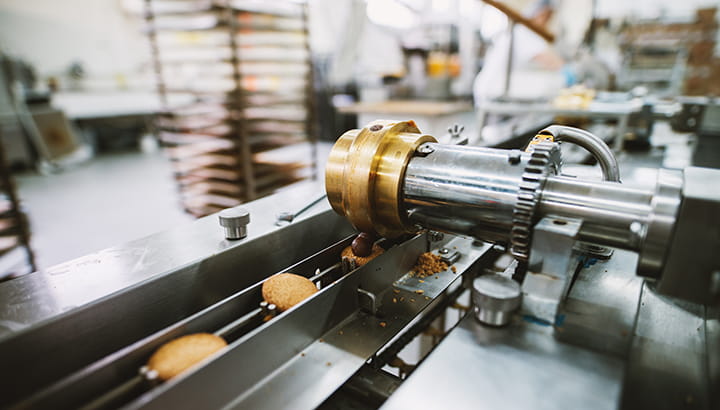
Organic dust material – sugar, flour, grain, spices and wood, for example – are just as combustible as metal dust. Minimizing the risks of a severe, or even fatal, explosion requires awareness – from both management and operators – as well as equipment that can adequately capture the dust and remove it from the production process.
Virtually any kind of organic dust may explode, if the moisture content is low enough. Seemingly harmless animal and agricultural ingredients used for broth, potato flour and similar products are no exception. Many industrial food processing plants add major amounts of spices, flavorings and starch to their products, often releasing huge dust clouds from sacks and other containers in the process. Mixing these substances with relatively moist products (such as fresh fruit or ground meat) removes the risk of an explosion, but until that happens, the dust can combust and cause major damage if coming into contact with an overheated engine, surface area or even a cigarette butt.
Even moist and thus supposedly safe dust materials can explode when finely ground and exposed to low humidity.
Nederman recently delivered a FlexFilter EX system to a Swedish tobacco company whose products are made from moist tobacco powder. As the powder usually contains a relatively high amount of moisture, it was not initially thought of as potentially explosive. The manufacturing and packaging processes, however, involve a certain degree of spillage. Once spilled into the open air, the tobacco powder will quickly become substantially drier, often losing over 90% of its moisture content in less than half an hour.
This significantly drier substance used to be removed about once every hour through a high vacuum dust collection filter system. Unfortunately, the system was working at such a high speed that the particles became even more finely ground when passing through the ducts, resulting in substantial amounts of fine, combustible dust accumulating in the system's ducts and dustbin. Moreover, the rubber cloth filter that was used at the time, in order to collect the particles, burst regularly, and thus had to be replaced at least twice a year.
As the dust travels through a pipe or duct, static electricity is built up. If too much dust is allowed to accumulate in the filter over time, and possibly inside the duct as well, it may well result in a major explosion.
A test was conducted where the tobacco product manufacturer’s main product was ground to very fine dust, and then sent to a company for analysis. At that company's test facility, the dust was ignited in order to measure its KST value. This value indicates the maximum rate of bar pressure rise, and makes it possible to estimate the anticipated behavior of the dust, particularly the likelihood and power of an explosion.
The KST value of the measured tobacco dust was about 70, which is notably higher than the dust created from wood shavings and rice, for example. However, it is worth pointing out that flour and sugar have KST values of about 150.
Following the risk assessment and the conclusion that the tobacco dust generated at their production plant did in fact pose a workplace hazard, the company decided to install a FlexFilter EX system. While this equipment cannot prevent the dust from exploding, it does evacuate the flame and hot air that will be created in such an event. A venting tunnel will absorb the fire and contain it by means of a back pressure valve. The filter would have to be replaced afterwards, and the reason for the explosion should be investigated thoroughly, but production can likely resume within 24 hours. The vacuum system also collects the excess tobacco powder and filters it for safe and easy deposit.
Without the necessary equipment in place to handle these kinds of dust explosions, the damages to personnel, panels and machines can be significant, and cause production to cease for a long period of time.
In many ways, the greatest hazard of combustible dust is to simply ignore the risks posed by it. Fortunately, awareness of the issue is growing, even though that awareness still varies considerably between different companies, industries and geographic regions. More and more companies include it as a potential risk factor in their workplace safety assessments, with regard to the products they make, and the amounts of dust created by the production.
The implementation of industrial housekeeping routines is an essential aspect of this work, as it helps provide a safe and sanitary environment for workers, equipment and products alike. Installing proper extraction arms, extraction hoods and other kinds of process ventilation means that dust will not be able to settle or spread to the extent it would otherwise, preventing explosions as well as human exposure to fumes and other hazardous particles.
In addition to awareness and appropriate equipment and cleaning procedures, the complexity of the production system itself is a factor that ought to be taken into account when building a new factory or production plant. A system that is intuitive and comparatively easy to operate will likely result in less damages, errors and maintenance.
Feel free to read my article on robotic welding and welding fume extraction, as well as my colleagues’ articles on industrial housekeeping and combustible dust, here at the Nederman Knowledge Center, and do not hesitate to contact me if you have any questions.
We have extensive experience of various challenges in the different industries and our experts are very skilled, helpful and professional. With us, you can feel secure that we take care of you and your needs. You are always welcome to contact us regardless if you have a short question or a more complex and complicated one. A warm welcome to Nederman.
Contact us here